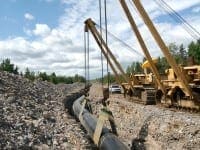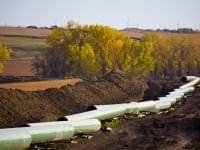A report on the policies that can support long-term jobs development and economic prosperity in the U.S.
A sharp decrease in oil prices directly affected jobs in oil and gas at the start of the year as firms reduced development investments and announced thousands of jobs cuts. This challenging near-term outlook, however, is being offset by an ongoing push for policies designed to underscore job growth and domestic economic prosperity. Support for more domestic use of oil and production of oil for export remains strong. A rise in natural gas demand continues as the U.S. Environmental Protection Agency (EPA) pushes tougher emissions standards, and efforts to modernize permitting processes are underway to ensure infrastructure can meet demand. These actions on the policy front will define oil and gas job opportunities beyond the near term and drive the sectors well into the next decade.
Economic dislocation
The recent trend in job cuts in oil and gas, while a stark contrast to growth trends the sectors were experiencing, should be put into perspective, explains Dan Kish, senior vice president for policy at the Institute for Energy Research.
“For anybody who has been in the oil business for any period of time, we’ve seen this before,” Kish said. “But what we’re seeing now might be a little different than what we’ve seen before, and I think the chapter has yet to be written.”
With the higher price of oil attracting capital over a long period of time, industry players attracted not only investments, but also personnel to try to sustain those investments, he said.
“People were hiring at just incredible rates,” Kish added. “Now, with the decline in [oil] prices, there is a lot of economic dislocation.”
That dislocation is the miracle of the capitalist system, Kish explained.
“It’s creative destruction in a lot of ways,” he said. “It forces people to sharpen their pencils.”
Kish expects that the oil and gas industry will experience a certain amount of consolidation.
“Some of the weaker companies that were maybe too leveraged are going to be attractive for other people to pursue because of their investments that will gain value later,” he said. “It happens in all markets – it’s part of the natural process.”
Kish believes that the market will rebound from the current downturn, as long as the government does not create a new regulatory environment that makes it more expensive to do business in the U.S.
The EPA’s recently proposed methane regulations constitute “a classic example” of the government coming into the market at the wrong time with the wrong approach for a paradigm that seeks to encourage domestic investment, Kish said.
Janet McCabe, Acting Assistant Administrator for the EPA Office of Air and Radiation on Jan. 14 released the details for a set of actions to cut methane emissions from the oil and gas sector by 40% to 45% from 2012 levels by 2025. (See News at a Glance, p. 32.) As part of that plan, the EPA will initiate a rulemaking to set standards for methane and volatile organic compounds emissions from new and modified oil and gas production sources, and natural gas processing and transmission sources.
In addition, President Obama’s FY16 budget includes $15 million in funding for the U.S. Department of Energy (DOE) to develop cost-effective technologies to detect and reduce losses from natural gas transmission and distribution systems and $10 million to
launch a program at DOE to enhance the quantification of emissions from natural gas infrastructure for inclusion in the national Greenhouse Gas Inventory.
The EPA’s actions on methane emissions come at a time when the reduction in methane by the oil and gas industry, according to EPA’s own reports, has been phenomenal, according to Kish.
“The problem with the government coming in and doing something along these lines is that, without the government, business has already been finding it in its own interest to reduce [emissions] so rapidly that, if they give them a few more years, they may reduce it to such an extent that nobody is concerned about it,” Kish said.
Keystone jobs
President Obama on Feb. 24 returned S.1, the Keystone XL Pipeline Approval Act, without his approval.
In a Feb. 24 message to the U.S. Senate, Obama said that, “through this bill, the United States Congress attempts to circumvent longstanding and proven processes for determining whether or not building and operating a cross-border pipeline serves the national interest.”
The Keystone XL Pipeline Approval Act, which would have approved TransCanada’s proposed Keystone XL pipeline project, had passed both the U.S. House of Representatives and the Senate, falling short of the two-thirds majority needed to override a presidential veto.
Earlier this year, President Obama agreed with a Secretary of State recommendation that the Keystone XL application should be denied. In a Jan. 7 statement, he said that, as the State Department made clear last December, “the rushed and arbitrary deadline insisted on by Congressional Republicans prevented full assessment of the pipeline’s impact, especially the health and safety of the American people, as well as our environment.”
President Obama also said that his administration would continue to look for new ways to partner with the oil and gas industry to increase energy security, “including the potential development of an oil pipeline from Cushing, Okla., to the Gulf of Mexico.”
In his Feb. 24 message to the Senate, President Obama said that he takes the Presidential power to veto legislation seriously.
“[B]ecause this act of Congress conflicts with established executive branch procedures and cuts short thorough consideration of issues that could bear on our national interest – including our security, safety, and environment – it has earned my veto.”
U.S. Senate Majority Leader Mitch McConnell, R-Ky., in a Feb. 24 statement expressed his disappointment in the veto.
“Even the President’s own State Department says construction of this jobs and infrastructure project would result in only minimal environmental impact,” he said. “Even though the President has yielded to powerful special interests, this veto doesn’t end the debate. Americans should know that the new Congress won’t stop pursuing good ideas, including this one.”
Sen. Lisa Murkowski, R-Ala., chairman of the Senate Energy and Natural Resources Committee, in a Feb. 24 statement also criticized President Obama’s veto, calling it a “short-sighted, politically-driven mistake.”
In a Feb. 24 statement responding to the veto, TransCanada said it remains fully committed to Keystone XL.
“As we have done throughout the permitting process, TransCanada will keep working in good faith with the Department of State and other federal agencies to address any outstanding concerns with regard to Keystone XL, including those that were most recently raised by the EPA,” TransCanada said.
On Feb. 2, the EPA submitted a letter to the State Department with comments on the final supplemental environmental impact statement (SEIS) for the project. In that letter, the EPA said that, given the recent variability in oil prices, it is necessary to revisit the final SEIS conclusion that development of oil sands would lead to significant additional releases of greenhouse gasses, and a decision not to grant the requested permit would likely not change that outcome.
According to the State Department, the number of jobs associated with the construction of the estimated $10bn Keystone XL pipeline over a two year period would be about 42,000.
That type of infrastructure project is exactly the development profile that President Obama has traditionally supported to boost the economy, Kish said.
The jobs associated with the construction of the pipeline may be temporary, but they’re high-paying and highly skilled, he added.
“They flush other jobs throughout the economy because of a consequence of people moving into an area to construct something on a large scale, and it puts new demands for services and purchases in the local communities,” he said.
If the U.S. can buy and use domestic oil instead of buying oil from other areas around the world, it attracts manufacturing processes to the U.S. and provides the initial investment as well as the ongoing jobs, according to Kish.
“If we’ve been used to taking hundreds of billions of dollars a year and buying energy with it from abroad and we stop doing that, and switch that focus to buying the same commodities produced in North America, we not only get the jobs from that but we also get the expansion of economic activity, the taxes, and all the wealth that goes with it,” he said.
On the flip side, Kish believes that shifting policies to support export of surplus oil and gas also would greatly benefit the jobs outlook.
“There’s increasing discussion in Washington of the export issue because we’re finding and producing supplies of both oil and gas that are surplus to our needs, and other people are willing to pay more for those products than we are here in the U.S.,” Kish said. “It makes sense to begin discussing export of them.”
Increasingly, studies are showing that if the U.S. raises the amount of oil it exports, it would help producers and consumers simultaneously – a win-win scenario that does not happen most of the time, according to Kish.
“There’s a growing understanding that we have enough oil here at home to not only serve our own needs and make sure that we get it at a reasonable price, but also to export it to other people around the world,” Kish said, noting that the idea will need “a lot more ripening in Congress.”
Permitting reform
The policy side of the energy industry is currently a highly dynamic space due to the Obama Administration’s focus on global warming goals and climate change, according to Kish.
“Applaud or criticize as people may, depending on where they are in the situation, the fact is that nobody should be surprised by what President Obama is doing,
and as a consequence, that has major ramifications for the energy picture in the U.S. and on economic growth,” Kish said. “Those actions all have a bearing on oil and gas.”
EPA regulation of coal-powered plant emissions under the Clean Power Plan will change how electricity is sourced in the U.S. over the next decade. Pressure to shutter nuclear generation, despite its highly affordable profile, will grow alongside the ongoing increases in state-level renewable energy mandates.
“These changes are going to necessitate huge investments not only in new natural gas power plants, but also in the transportation systems related to those plants,” Kish said.
Job growth in the natural gas sector will rise with that demand, but additional policies are necessary to support the benefit.
That rapid growth in demand for natural gas for power plants has not been met by expediting construction of the pipelines necessary to get the natural gas to the areas it is needed the most, Kish noted.
“In the very places where we need additional pipeline capacity, they’re running into trouble locally and also with federal permitting,” he said.
Recent bills that seek to streamline the permitting process are gaining ground in Washington. The bills are designed to ensure that permitting and construction of pipelines are coordinated so that there isn’t lag time between having the natural gas to fire the new plants and when the power is needed, Kish said.
The House Energy and Commerce Committee on Feb. 9 released a framework for advancing several energy reform initiatives that would include creating an efficient approval process for cross-border oil and gas pipelines.
The committee will prepare a series of discussion drafts under its Architecture of Abundance initiative to address policies that would modernize infrastructure, develop a 21st century energy workforce, and promote energy diplomacy, efficiency and accountability, according to a Feb. 9 committee statement.
In a combined statement on Feb. 9, House Energy and Commerce Committee Chairman Fred Upton (R-Mich.) and House Energy and Power Subcommittee Chairman Ed Whitfield (R-Ky.) said: “Our energy realities have changed dramatically – we’ve gone from bust to boom practically overnight. Today’s energy policies are lagging far behind, and are better suited for the gas lines in the 1970s than this new era of abundance. We need policies that meet today’s needs and are focused on the future, and that starts with building the Architecture of Abundance.”
The committee said it will advance the discussion drafts through the committee’s legislative process in the coming months and bring an energy package to the House floor later this year.
According to the framework, a discussion draft to modernize the transmission, reliability, and security of energy distribution will address the permitting challenges for current domestic and cross-border pipelines. It will also seek to protect critical energy infrastructure with improved emergency coordination and information sharing, ensure robust and transparent energy markets, and bring added levels of accountability to decision-makers.
Upton unveiled the Architecture of Abundance initiative at the Energy Information Administration 2014 Energy Conference in Washington, D.C., last July. His plan laid out several steps that the House has taken toward achieving the goals of the plan, including House passage on June 24, 2014, of H.R. 3301, the North American Energy Infrastructure Act, according to a July 2014 committee statement.
The North American Energy Infrastructure Act would consolidate and standardize the cross-border approval process for pipelines by eliminating the presidential permit requirement for cross-border facilities and requiring a certificate of crossing to be issued for cross-border facilities within 120 days of completion of an environmental review. The Federal Energy Regulatory Commission (FERC) would continue to approve cross-border natural gas pipelines under the act. On June 26, 2014, the act was placed on the U.S. Senate Legislative Calendar No. 422 under General Orders, according to the House website. No further action was taken.
Sen. John Hoeven (R-N.D.) introduced a similar bill – S. 2823 – to the Senate last September. The Senate read the bill on Sept. 19, 2014, and referred it to the Senate Committee on Energy and Natural Resources, according to the Senate website.
As part of the Architecture of Abundance framework, the Energy and Commerce Committee said it will seek to expand the U.S. energy and manufacturing workforce to include more minority and low-income communities. The discussion drafts will support opportunities for the DOE, along with the national laboratories, community colleges, and public-private partnerships, to coordinate and leverage existing resources to foster an energy and manufacturing workforce. In addition, the committee said the discussion drafts will seek to improve coordination and strengthen energy partnerships with Canada and Mexico and to establish a process to evaluate how energy permitting decisions impact international energy security.
Upton’s Architecture of Abundance framework also supports the Natural Gas Pipeline Permitting Reform Act. Introduced in July 2013 as H.R. 1900 and reintroduced in January as H.R. 161, the bill amends the Natural Gas Act to require that FERC approve or deny a pipeline certificate within 12 months of receiving the complete application.
The bill requires that any relevant agencies responsible for issuing a license, permit, or approval under federal law in connection with the project approve or deny the request within 90 days after FERC’s issuance of the final environmental document. FERC may extend the 90-day period by 30 days if the relevant agency demonstrates it cannot complete its review on time. If the relevant agency does not approve or deny the request within the specified time, approval of the request will take effect.
The bill passed in the House on Jan. 21, and the Senate received the bill on Jan. 22.
On Jan. 29, the Senate Energy and Natural Resources Committee heard testimony regarding the LNG Permitting Certainty and Transparency Act (S. 33), sponsored by Sens. Martin Heinrich (D-N.M.) and John Barrasso (R-Wyo.). The bill is designed to expedite the approval process for LNG exports to countries with which the U.S. does not have a free trade agreement. (See News at a Glance, p. 32.)
S. 33 directs the Secretary of Energy, for proposals that must also obtain authorization from FERC or the United States Maritime Administration to site, construct, expand, or operate LNG export facilities, to issue a decision on an application for authorization to export natural gas within 45 days after the later of the conclusion of an environmental review or the enactment date of the act.


















